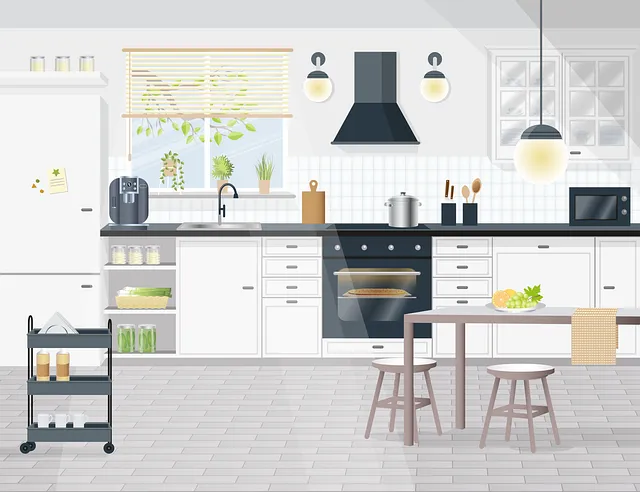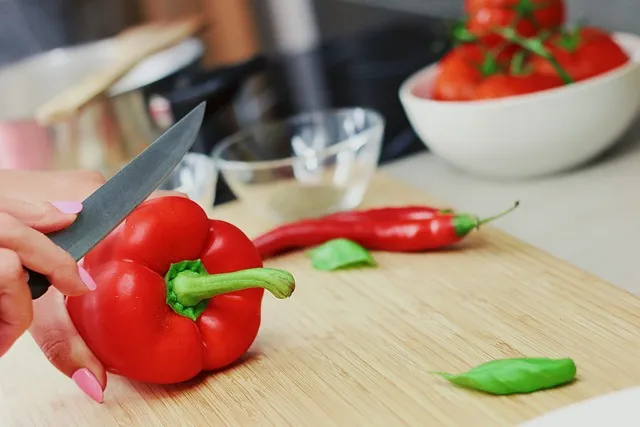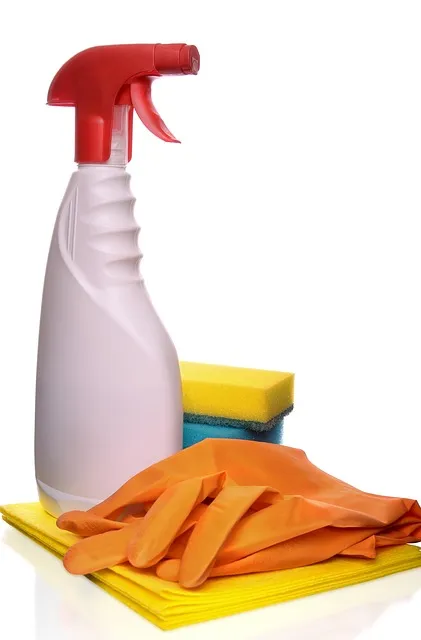Understanding your kitchen floor's material (tile, wood, vinyl) is key to effective cleaning. Use appropriate cleaners and techniques for each type. Regularly sweep/vacuum, spot clean, and deep scrub to maintain hygiene and prevent stains. Employ tools like vacuums, floor scrubbers, microfiber cloths, and non-toxic cleaners. Promptly address stains; use natural solutions like baking soda and vinegar. Maintain a consistent cleaning routine for daily sweeping/vacuuming and weekly deep cleans. Prioritize safety with gloves, ventilation, and careful handling of equipment. For stubborn stains, consider professional kitchen floor cleaning services.
Keeping your kitchen floor clean is essential for a hygienic and aesthetically pleasing space. This comprehensive guide delves into the intricacies of residential kitchen floor cleaning, offering insights tailored to various surface types. We explore the significance of regular cleaning routines and equip you with the knowledge to select the right tools and natural solutions. From step-by-step cleaning methods to stain removal tips and safety considerations, this article is your one-stop resource for achieving a sparkling kitchen floor.
Understanding Your Kitchen Floor Surface Types

When it comes to residential kitchen floor cleaning, understanding your surface type is key. Different floors require distinct care routines and cleaning products. Whether you’ve got sleek tile, warm wood, or robust vinyl, each material has unique characteristics that demand specialized attention. Proper identification allows for effective cleaning that preserves the floor’s beauty and longevity.
For instance, ceramic and porcelain tiles are non-porous, making them relatively easy to maintain with regular mopping and a mild detergent. Wood floors, however, need more delicate treatment to avoid water damage and wood stain penetration. Vinyl flooring is versatile but requires specific cleaners to prevent fading or peeling. Knowing your kitchen floor’s composition empowers you to choose the right cleaning methods and products for optimal results.
The Importance of Regular Cleaning Routines

Maintaining a clean kitchen floor is an essential part of regular cleaning routines. Kitchen floors often bear the brunt of daily activity, from spills and splashes to tracking in dirt and debris. Regular cleaning not only keeps your space looking neat and tidy but also plays a crucial role in hygiene and disease prevention. A clean kitchen floor reduces the risk of slips and falls, ensuring safer movement for you and your family.
Moreover, consistent floor cleaning can prevent harsh stains from setting in, making it easier to maintain the floor’s appearance over time. Effective kitchen floor cleaning routines involve using suitable products and techniques tailored to the floor type, whether it’s tile, hardwood, or vinyl. Regular mopping, spot cleaning, and deep scrubbing help remove dirt, grease, and bacteria buildup, ensuring a hygienic and inviting cooking environment.
Essential Tools and Equipment for Effective Cleaning

When it comes to efficient kitchen floor cleaning, the right tools make all the difference. Start with a good quality vacuum cleaner designed for hard floors; this will effectively remove dirt, debris, and even small food particles from the surface. For more stubborn stains and marks, invest in a floor scrubber or a manual scrub brush with replaceable pads to deep clean and restore shine. Don’t underestimate the power of microfiber cloths—they’re perfect for mopping up spills, wiping down counters, and drying floors without leaving streaks.
Don’t forget about specialized cleaning solutions tailored for kitchen floors. A mild, non-toxic cleaner will effectively tackle everyday grime while a stronger, bleach-based option can handle tougher stains. Always test any new product on a small, inconspicuous area first to ensure it won’t damage or discolour your floor. Proper equipment and the right products will make kitchen floor cleaning a breeze, leaving your space sparkling and hygienic in no time.
Step-by-Step Guide to Deep Cleaning Your Kitchen Floor

Start by clearing all surfaces and removing any furniture from the floor area. This step is crucial for accessing every nook and cranny during cleaning. Next, sweep or vacuum to collect dirt, debris, and loose dust particles. For more stubborn stains, apply a suitable kitchen-specific cleaning agent or detergent. Use a mop or sponge to work the cleaner into the floor, following the product’s instructions.
Rinse thoroughly with clean water to remove any residue left behind by the cleaning solution. Dry the floor promptly using a microfiber cloth or towel to prevent water damage and ensure a streak-free finish. Regular deep cleaning sessions will maintain your kitchen floor’s hygiene and longevity.
Natural Cleaning Solutions for a Healthy Home

Maintaining a clean kitchen floor not only keeps your home aesthetically pleasing but also contributes to a healthier living environment. Opting for natural cleaning solutions is an eco-friendly and non-toxic approach that many homeowners are adopting. These solutions offer a safe and effective way to remove dirt, grime, and stains without harsh chemicals.
Simple ingredients like baking soda, vinegar, and lemon juice are powerful allies in kitchen floor cleaning. Baking soda acts as a natural scrubber, effectively eliminating tough stains. Vinegar’s acidity helps to break down grease and grime, leaving floors sparkling. Lemon juice, rich in antioxidants, adds a fresh scent and its antibacterial properties ensure a hygienic clean. Combining these natural agents with warm water creates a versatile cleaning mixture that can tackle various kitchen floor issues without causing any damage or health risks.
Dealing with Common Stains and Discolorations

When it comes to kitchen floor cleaning, dealing with common stains and discolorations is an inevitable part of maintaining a sparkling space. Over time, spills, drops, and general wear and tear can leave unsightly marks on your floors. The good news is that many kitchen floor types can be easily restored to their original gleam. For example, ceramic tile and vinyl flooring can often be cleaned with warm soapy water and a soft-bristled brush or mop. This simple yet effective method removes surface dirt and grime without causing any damage.
For more stubborn stains, like those from food or grease, using specialized cleaning products designed for kitchen floors is recommended. Additionally, baking soda or vinegar can be natural alternatives to chemical cleaners. These substances not only tackle tough spots but also leave a fresh scent. Regularly addressing stains promptly prevents them from setting in and causing deeper discoloration. Keeping your kitchen floor cleaning routine consistent ensures a clean and inviting space that complements the heart of your home.
Tips for Maintaining Shine and Longevity

Regular maintenance is key to keeping your kitchen floor clean and shiny, extending its lifespan significantly. Start by sweeping or vacuuming daily to remove dirt and debris that can accumulate and damage the surface. This simple step prevents grime buildup, making deep cleaning easier and less frequent.
For long-lasting results, invest in a good quality floor cleaner designed specifically for kitchen use. Use it regularly to wipe away spills and stains promptly. Remember, the key is consistency; a little effort every day keeps your kitchen floor looking its best and ensures you’re not dealing with a major clean once a week.
Safety Considerations When Cleaning Kitchen Floors

When it comes to cleaning kitchen floors, safety should always be a top priority. This is because kitchen floors often come into contact with hot surfaces, sharp objects, and various chemicals used in food preparation and cleaning. Always wear protective gear, such as rubber gloves and closed-toe shoes, to avoid burns or cuts. Additionally, ensure the floor is dry before walking on it to prevent slips and falls, especially when using slippery cleaning solutions.
Proper ventilation is another crucial safety consideration. Many kitchen floor cleaners release fumes that can be harmful if inhaled in enclosed spaces. Open windows and doors, or use a well-ventilated area, to disperse these fumes effectively. Moreover, be cautious when handling heavy cleaning equipment or furniture to avoid accidents, especially on wet floors. Regularly inspect your kitchen floor for any damaged areas or loose tiles before beginning the cleaning process to mitigate potential risks.
Professional Help: When to Consider Experts

Maintaining a clean kitchen floor is essential for hygiene and aesthetics, but sometimes, despite our best efforts, stains and grime can be stubborn and hard to remove. This is when considering professional help for kitchen floor cleaning becomes important. Experts in this field have access to specialized equipment and powerful yet safe cleaning solutions that can tackle even the most challenging kitchen floor issues.
Regular DIY cleaning methods might not cut it for heavily soiled or textured floors. Professional cleaners understand the unique requirements of different flooring materials, from tiles and vinyl to hardwood and stone. They offer deep cleaning services, including steam cleaning, scrubbing, and sanitizing, ensuring that your kitchen floor is not just visually appealing but also hygienically clean.
